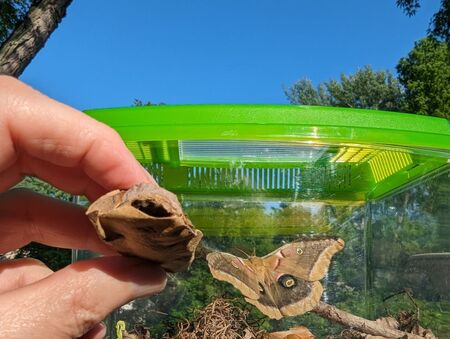
Good Natured: Polyphemus Moth and Cocoon Part Two
Last week we spent some time getting to know Poly Pupa, the cocoon produced by a polyphemus moth we found last fall. Over the ensuing months, he underwent a series of changes that resulted in Poly Mothman, a splendid example of the species. He was subsequently released, leaving behind his cocoon, and a mystery: How the heck did he get out of there?
Poly's cocoon was a study structure. It had to be, given its function of protecting the developing pupa from the double-whammy ravages of weather plus foraging wildlife. (Pupae are valued for their fat and protein, and complete inability to fight back.)
Moths, by contrast, are fairly delicate creatures. As I looked Poly over from head to thorax to abdomen, I saw no parts that looked capable of making a hole in hardened silk.
Hmm.
I also knew he couldn't have chewed his way to freedom.
Polyphemus caterpillars have impressive mandibles, but polyphemus moths do not. In fact, they don't really have mouths at all. Because they do all their feeding in the caterpillar stage, adults have what are called vestigial mouthparts; basically everything in that area has been reduced. A polyphemus moth's focus during this final, brief—maybe a week or so—life stage is to find a mate and procreate. Period.
(Note: Not all moths forsake feeding. Many actually are valuable pollinators, dabbing their proboscises, or tongues, into flowers, sipping nectar and moving pollen from plant to plant.)
Even if Poly did feed, his proboscis wouldn't be much help. The soft appendage works great as a siphon, but is not at all useful for punching through a silken wall.
Huh.
As I looked at Poly's feet, I saw he had tiny little claws. Could these be the answer? They seemed well suited for gripping, and possibly tearing, BUT… I couldn't picture how he could possibly have maneuvered himself enough within that small chamber to dig his way out.
His situation inside the cocoon reminded me of the time I got stuck in a sleeping bag. Even with arms, hands and fingers, and a zipper for heaven's sake, it still took me a pathetically long time to emerge. I eventually got out, and so did he. But, again, how??
After falling down more than a few online rabbit holes, I found a most wondrous paper: Pupal Escape Mechanism of Certain Saturniid Moths. Published in the December 1965 volume of The Florida Entomologist and written by by Harry O. Hilton (a U.S. Air Force Major who in retirement became enamored of insects), the article describes in delightful detail, complete with photos, exactly how Poly and his kin execute their escape. Hilton also included a nice summary of the process:
“Normal emergence of the adult consists of these three interrelated actions: softening of the threads by saturating the threads at the head end of the cocoon with a fluid; ripping and tearing of the threads already softened by use of the spurs on the wings; and exerting constant pressure on the end of the cocoon with the head and upper thorax."
Aha! Spurs! These structures help explain part of the puzzle. But what about this mysterious fluid the moth produces?
That answer, found in another rabbit hole, is explained in the paper, Preliminary Characterization of a Proteolytic Enzyme from Silk Moths by Fotis C. Kafatos, Alan M. Tartakoff and John H. Law. It was published in the April 10, 1967 issue of The Journal of Biological Chemistry and tells us, over 10 pages complete with charts and graphs, how moths like Poly produce an enzyme called cocoonase.
Believe me, there is a lot of great analysis there of what makes this enzyme so good at what it does. But the condensed version goes something like this: Cocoonase is produced and released by the moth's mouthparts that would have become the proboscis. It digests the protein sericin, a gelatinous “glue" that holds the silk together, and enables the moth to create the opening it needs.
So, like a naturalist trapped in a bedroll, Poly trundled about inside his cocoon, hoping to gain his freedom. But unlike the poor human (who eventually had to ask for help) Poly used chemistry and sharp spurs to create a hole just large enough to crawl out of.
Today Poly Mothman is long gone. I'm hopeful that his successful eclosion set him up for a successful flight, and a successful coupling with a neighborhood lady moth. I'll be keeping my eyes open in the coming weeks for polyphemus eggs (which look remarkably like tiny buckeye candies) affixed to leaves or, more likely, another polyphemus caterpillar, so we can watch the whole amazing process again.
Pam Otto is the outreach ambassador for the St. Charles Park District. She can be reached at potto@stcparks.org.

